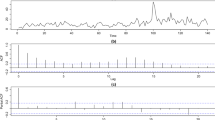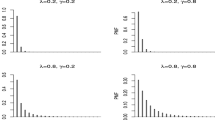Abstract
This paper considers the modeling problem of the weekly number of districts with new cases of cryptosporidiosis infection, and proposes a covariate-driven beta-binomial integer-valued GARCH model with a logit transformation to illustrate such bounded integer-valued time series data with extra-binomial variation and high volatility. We establish the existence of the stationary and ergodic solution by imposing a contraction condition on its conditional mean process and a Markov structure on the incorporated covariate process, consider the conditional maximum likelihood (CML) estimator for the parameter vector and discuss its asymptotic properties, conduct a simulation study to examine the finite sample performance of the CML estimator for the proposed model with three data generating mechanisms of the covariate process. Finally, an application to the weekly number of districts with new cases of cryptosporidiosis infection is considered to illustrate the superior performance of the proposed model.






Similar content being viewed by others
References
Agosto A, Cavaliere G, Kristensen and Rahbek A, (2016) Modeling corporate defaults: Poisson autoregressions with exogenous covariates (PARX). J Empir Financ 38:640–663
Aknouche A, Francq C (2021) Count and duration time series with equal conditional stochastic and mean orders. Econom Theor 37:248–280
Alomani GA, Alzaid AA, Omair MA (2018) A Skellam INGARCH model. Braz J Probab Stat 32:200–214
Amemiya T (1985) Advanced econometrics. Harvard University Press, Cambridge
Chen CW, Khamthong K (2020) Bayesian modelling of nonlinear negative binomial integer-valued GARCHX models. Stat Model 20:537–561
Chen CW, Khamthong K, Lee S (2019) Markov switching integer-valued generalized autoregressive conditional heteroscedastic models for dengue counts. J R Stat Soc Ser C 68:963–983
Chen H, Li Q, Zhu F (2020) Two classes of dynamic binomial integer-valued ARCH models. Braz J Probab Stat 34:685–711
Chen H, Li Q, Zhu F (2021) Binomial AR(1) processes with innovational outliers. Commun Stat-Theory Methods 50:446–472
Chen H, Li Q, Zhu F (2022) A new class of integer-valued GARCH models for time series of bounded counts with extra-binomial variation. AStA Adv Stat Anal 106:243–270
Cui Y, Lund R (2010) Inference in binomial AR(1) models. Stat Probab Lett 80:1985–1990
Cui Y, Li Q, Zhu F (2021) Modeling \(\mathbb{Z} \)-valued time series based on new versions of the Skellam INGARCH model. Braz J Probab Stat 35:293–314
Davis RA, Dunsmuir WM, Wang Y (2000) On autocorrelation in a Poisson regression model. Biometrika 87:491–505
Davis RA, Liu H (2016) Theory and inference for a class of observation-driven models with application to time series of counts. Stat Sin 26:1673–1707
Davis RA, Fokianos K, Holan SH, Joe H, Livsey J, Lund R, Pipiras V, Ravishanker N (2021) Count time series: a methodological review. J Am Stat Assoc 116:1533–1547
Doukhan P, Wintenberger O (2008) Weakly dependent chains with infinite memory. Stoch Process Appl 118:1997–2013
Gorgi P (2020) Beta-negative binomial auto-regressions for modelling integer-valued time series with extreme observations. J Roy Stat Soc B 82:1325–1347
Hu X (2016) Volatility estimation for integer-valued financial time series. PhD thesis, Northwestern University
Kim HY, Weiß CH, Möller TA (2020) Models for autoregressive processes of bounded counts: How different are they? Comput Stat 35:1715–1736
Kristensen D, Rahbek A (2005) Asymptotics of the QMLE for a class of ARCH(\(q\)) models. Econom Theor 21:946–961
Lee Y, Lee S (2019) CUSUM test for general nonlinear integer-valued GARCH models: comparison study. Ann Inst Stat Math 71:1033–1057
Luffman I, Tran L (2014) Risk factors for E.coli O157 and cryptosporidiosis infection in individuals in the karst valleys of East Tennessee, USA. Geosciences 4:202–218
McKenzie E (1985) Some simple models for discrete variate time series. Water Resoure Bulletin 21:645–650
Ristić MM, Weiß CH, Janjić AD (2016) A binomial integer-valued ARCH model. Int J Biostat 12:20150051
Straumann D, Mikosch T (2006) Quasi-maximum-likelihood estimation in conditionally heteroscedastic time series: a stochastic recurrence equations approach. Ann Stat 34:2449–2495
Ursu E, Pereau J (2017) Estimation and identification of periodic autoregressive models with one exogenous variable. J Korean Stat Soc 46:629–640
Weiß CH (2009) Monitoring correlated processes with binomial marginals. J Appl Stat 36:399–414
Weiß CH (2009) Jumps in binomial AR(1) processes. Stat Probab Lett 79:2012–2019
Weiß CH (2009) A new class of autoregressive models for time series of binomial counts. Commun Stat-Theory Methods 38:447–460
Weiß CH (2018) An introduction to discrete-valued time series. Wiley, Chichester
Weiß CH and Jahn M (2022). Soft-clipping INGARCH models for time series of bounded Counts. Stat Model (forthcoming). https://doi.org/10.1177/1471082X221121223
Weiß CH, Kim HY (2014) Diagnosing and modeling extra-binomial variation for time-dependent counts. Appl Stoch Model Bus Ind 30:588–608
Weiß CH, Pollett PK (2012) Chain binomial models and binomial autoregressive processes. Biometrics 68:815–824
Weiß CH, Pollett PK (2014) Binomial autoregressive processes with density-dependent thinning. J Time Ser Anal 35:115–132
Weiß CH, Zhu F, Hoshiyar A (2022) Softplus INGARCH models. Stat Sin 32:1099–1120
Xu Y, Zhu F (2022) A new GJR-GARCH model for \(\mathbb{Z} \)-valued time series. J Time Ser Anal 43:490–500
Zhu F, Wang D (2015) Empirical likelihood for linear and log-linear INGARCH models. J Korean Stat Soc 44:150–160
Acknowledgements
The authors thank the Editor-in-Chief and the anonymous referee for the valuable comments and suggestions that result in a substantial improvement of this paper. Chen’s work is supported by Natural Science Foundation of Henan Province (No. 222300420127) and Postdoctoral research in Henan Province (No. 202103051). Li’s work is supported by National Natural Science Foundation of China (No. 12201069), Natural Science Foundation of Jilin Province (No. 20210101160JC), Science and Technology Research Project of Jilin Provincial Education Department (No. JJKH20220820KJ) and Natural Science Foundation Projects of CCNU (CSJJ2022006ZK). Zhu’s work is supported by National Natural Science Foundation of China (No. 12271206), and Natural Science Foundation of Jilin Province (No. 20210101143JC). Natural Science Foundation of Changchun Normal University, National Natural Science Foundation of China (11871027). National Natural Science Foundation of China (11731015).
Author information
Authors and Affiliations
Corresponding author
Additional information
Publisher's Note
Springer Nature remains neutral with regard to jurisdictional claims in published maps and institutional affiliations.
Appendix: Proof
Appendix: Proof
Theorem 1 Denote \({\varvec{Z_t}}=(Y_t,{\varvec{X}}_t)^{\top }\) and \(\nu _t=\mathrm{{logit}}(p_{t})\). Then \(\nu _t=w+\alpha \nu _{t-1}+\beta Y_{t-1}+f(\varvec{X}_{t-1}, {\varvec{\gamma }})\) If \(\varvec{{\widetilde{Z}}_t}=({\widetilde{Y}}_t,\widetilde{p}_t,\widetilde{\varvec{X}}_t)^{\top }\) exists, then \(E\Vert \varvec{{\widetilde{Z}}_t} \Vert ^{s}<\infty \) because \(Y_t\) is finite.
Denote \(\mathscr {B}(\mathcal {B})=1-\alpha \mathcal {B}\) with \(\mathcal {B}\) being lag operator, then \(\nu _t\) can be rewritten as \(\mathscr {B}(\mathcal {B}) \nu _t=w+\beta Y_{t-1}+f({\varvec{X}}_{t}, {\varvec{\gamma }}).\) Denote \(\Psi (\mathcal {B})=\mathscr {B}^{-1}(z)=1/(1-\alpha \mathcal {B})=\sum _{i=0}^{+\infty }\psi _{i}\mathcal {B}^i\), where \(\psi _0=1\) and \(\psi _i=\alpha ^i,\forall i\ge 1.\) Hence, \( \nu _t={w}/(1-\alpha )+\beta \Psi (\mathcal {B}) Y_{t-1}+\Psi (\mathcal {B})f({\varvec{X}}_{t},{\varvec{\gamma }}) \) by \(\mathscr {B}(1)=1-\alpha \). Thus, \({\varvec{Z_t}}\) can be rewritten as a Bernoulli-shift structure, which is denoted as \( {\varvec{Z_t}}:= G({\varvec{Z_{t-1}}},{\varvec{Z_{t-2}}},\cdots ; {\varvec{\xi _{t}}}) =\big (F_{p_t}^{-1}(u_t),h({\varvec{X}}_{t-1},\epsilon _t)\big )^{\top }, \) where \({\varvec{\xi _{t}}} =\big (F_{p_t}^{-1}(u_t),\epsilon _t\big )^{\top }\) is an i.i.d. sequence by (4) and (5). It is easy to see condition (3.3) of Theorem 3.1 in Doukhan and Wintenberger (2008) holds.
In the following, we show that \({\varvec{Z_t}}\) satisfies the conditions (3.1) and (3.2) of Theorem 3.1 in Doukhan and Wintenberger (2008). Define \(\Vert \varvec{Z}_t \Vert _\tau =|Y_t|+\tau \Vert {\varvec{X}}_t\Vert \), if \(\varvec{Z}_t=(Y_t,{\varvec{X}}_t)^{\top }\), \(\tau >0\) and \({\varvec{X}}_t\) is a d-dimension vector. Then, for any two deterministic sequences \(\{{{\varvec{z}}_{{\varvec{t-i}}}}\}\) and \(\{{{\widetilde{{\varvec{z}}}}_{t-i}}\}\), \(i=1,2,\cdots \), we obtain
where \(\varsigma _1=\max \big (4^{-1}|\beta |, (4\tau )^{-1}L+\rho \big )\), \(\varsigma _i =\max \big (4^{-1}|\beta | , (4\tau )^{-1} L\big )|\psi _{i-1}| =\max \big (4^{-1}|\beta | , (4\tau )^{-1} L\big )|\alpha |^{i-1}\), \(\forall i\ge 2.\) Hence, (3.1) in Doukhan and Wintenberger (2008) holds.
Note that \(|\beta |<4(1-|\alpha |)\) and \(|\alpha |<1\), hence, \(4^{-1}|\beta |\sum _{i=1}^{+\infty } |\alpha |^{i-1}=|\beta |/(4(1-|\alpha |))<1\). If \(L = 0\), \(\sum _{i=1}^{+\infty } \varsigma _i = \max \big (4^{-1}|\beta |,\rho \big )+ \sum _{i=2}^{+\infty } 4^{-1}|\beta | |\alpha |^{i-1} =\max \left( |\beta |/(4(1-|\alpha |)), \rho +|\alpha \beta |/(4(1-|\alpha |))\right) <1\) by \(\rho <1-{|\alpha \beta |}/\big (4(1-|\alpha |)\big )\), \(|\beta |<4(1-|\alpha |)\) and \(|\alpha |<1\). If \(L>0\), choosing \(\tau \) arbitrarily large such that \( \rho + (4\tau )^{-1} L \sum _{i=1}^{+\infty } |\alpha |^{i-1} =\rho + {L}/\big ({4\tau }(1-|\alpha |)\big )<1\). To sum up, \(\sum _{i=1}^{+\infty }\varsigma _i<1\), i.e., (3.2) in Doukhan and Wintenberger (2008) hold. Therefore, \(\{\varvec{Z}_t\}\) is weakly dependent. This concludes the proof.
Theorem 2(1). Denote \({l}_t(\varvec{\eta })=\log {P_{n}(X_t|\mathcal {F}_{t-1})}:=\log {P_{n}}\) and \({\widetilde{l}}_t({\varvec{\eta }}) =\log {P_n(Y_t|{\widetilde{p}}_t({\varvec{\eta }}))} =\log {\widetilde{P}_n},\) where \(\mathrm{{logit}}\big (\widetilde{p}_t(\varvec{\eta })\big )=w+\alpha \mathrm{{logit}}\big (\widetilde{p}_{t-1}(\varvec{\eta })\big )+\beta {\widetilde{Y}}_{t-1} +f(\widetilde{\varvec{X}}_{t-1},{\varvec{\gamma }}), ~t \in \mathbb {Z}\) and \(\forall \eta \in \Omega \), \(\mathrm{{logit}}(p_t)\) satisfies iterative relationship
Hence, there exists a positive constant \(\delta \) such that \(\dfrac{w}{1-\alpha }-\delta \le \mathrm{{logit}}({\widetilde{p}}_t) \le \dfrac{w}{1-\alpha }+\delta \). Thus,
Note that \(E({\widetilde{Y}}_t)=nE({\widetilde{p}}_t)\), thus, \(n\delta _1\le E({\widetilde{Y}}_t)\le n\delta _2\), i.e., there exists a positive constant \(\delta _3\) such that \(c_1:=n\delta _1+\delta _3\le {\widetilde{Y}}_t\le \delta _3+ n\delta _2=:c_2.\)
Note that \(\widetilde{l}_t(\varvec{\eta })\) is a measurable function of \({X}_t\) for all \(\varvec{\eta } \in \Omega \), and is continuous in an open and convex neighbourhood \(N(\varvec{\eta }_0)\) of \(\varvec{\eta }_0\), then there at least exists a point \(\overline{\varvec{\eta }} \in N(\varvec{\eta }_0)\) such that \({l}_t(\varvec{\eta })\) attains the maximum value at \(\overline{\varvec{\eta }}\). Thus,
Hence,
in probability as \(T\rightarrow \infty \) by Proposition 2 in Kristensen and Rahbek (2005). By Jensen’s inequality and Assumption 2,
with equality if and only if \({P_{n}(\widetilde{Y}_t|\widetilde{p}_{t})_{\varvec{\eta }}}= {P_{n}(\widetilde{Y}_t|\widetilde{p}_{t})_{\varvec{\eta }_0}}.\) Thus, \(E{{\widetilde{l}}}_t(\varvec{\eta })\) attains a strict local maximum at \(\varvec{\eta }_0\). Then the consistence of \(\hat{{\varvec{\eta }}}_T^{cml}\) can be obtained by \(\text {(I)}:=\Vert {\ell }_T({\varvec{\eta }}) - \overline{{\widetilde{\ell }}~}({\varvec{\eta }})\Vert _{\Omega } ~{{\mathop {\longrightarrow }\limits ^{a.s.}}} ~0,~T\rightarrow \infty .\) Note that
Using (A.1), \({\text {(III)}}~{{\mathop {\longrightarrow }\limits ^{a.s.}}} ~0, ~T\rightarrow \infty .\) By Lemma 2.1 in Straumann and Mikosch (2006) and Assumption 3, \(\forall t\ge N, N \in \mathbb {N}\), \(\sum _{t=N}^{\infty }\zeta _t \Vert p_t({\varvec{\eta }}) - {\widetilde{p}}_t({\varvec{\eta }}) \Vert _{\Omega }\) converges a.s., hence \(\sum _{t=N}^{\infty }\Vert l_t({\varvec{\eta }}) - {\widetilde{l}}_t({\varvec{\eta }}) \Vert _{\Omega }<\infty .\) Thus, \(\text {(II)}~{{\mathop {\longrightarrow }\limits ^{a.s.}}}~0, ~T\rightarrow \infty \). Therefore, we have \(\text {(I)}~{{\mathop {\longrightarrow }\limits ^{a.s.}}} ~0, ~T\rightarrow \infty \). Then, the CML estimator \(\hat{{\varvec{\eta }}}_T^{cml}\) is strongly consistent with respect to \({\varvec{\eta }}_0.\) Hence, part (1) holds.
(2).The proof of part 2 relies on the Taylor series expansion of the score vector around \({\varvec{\eta }}_0\). We have
where \(\varvec{\eta }^{\star }\) lies in between \(\hat{\varvec{\eta }}_T^{cml}\) and \({\varvec{\eta }}_0\). According to Theorem 4.1.3 of Amemiya (1985), we need to show that
which can be obtained by the method in Theorem 4 (Chen et al. 2020), \(\varvec{{{\widetilde{\eta }}}}_T^{cml}\) is asymptotic normality. Similar to Theorem 3 in Chen et al. (2022), we obtain
\(\text {(a).}~~ T^{-1/2}\dfrac{\partial {\widetilde{\ell }{({{\varvec{\eta }}_0})}}}{\partial {\varvec{\eta }}} ~{{\mathop {\longrightarrow }\limits ^{d}}}~N(\varvec{0},\varvec{I}(\varvec{\eta }_0)) ~\text {with}~ \varvec{I}(\varvec{\eta }_0):=E\left[ \dfrac{\partial { {\widetilde{l}}_t({\varvec{\eta }_0})}}{\partial {\varvec{\eta }}} \dfrac{\partial { \widetilde{l}_t({\varvec{\eta }_0})}}{\partial {\varvec{\eta }^{\top }}} \right] .\)
\(\text {(b)}.~~ \dfrac{1}{T} \dfrac{\partial ^2{{{\widetilde{\ell }}}({\varvec{\eta }^{\star })}}}{\partial {\varvec{\eta }}\partial {\varvec{\eta }^{\top }}}~ {\mathop {\longrightarrow }\limits ^{p}}~ -{\varvec{H}}({\varvec{\eta }}_0):= E\dfrac{\partial ^2{{\widetilde{l}}_t({\varvec{\eta }_0)}}}{\partial {\varvec{\eta }}\partial {\varvec{\eta }^{\top }}},\) where \(\varvec{\eta }^{\star }\) lies in between \(\hat{\varvec{\eta }}_T^{cml}\) and \({\varvec{\eta }}_0\).
Thus, the result in part (2) holds.
Rights and permissions
Springer Nature or its licensor (e.g. a society or other partner) holds exclusive rights to this article under a publishing agreement with the author(s) or other rightsholder(s); author self-archiving of the accepted manuscript version of this article is solely governed by the terms of such publishing agreement and applicable law.
About this article
Cite this article
Chen, H., Li, Q. & Zhu, F. A covariate-driven beta-binomial integer-valued GARCH model for bounded counts with an application. Metrika 86, 805–826 (2023). https://doi.org/10.1007/s00184-023-00894-5
Received:
Accepted:
Published:
Issue Date:
DOI: https://doi.org/10.1007/s00184-023-00894-5




